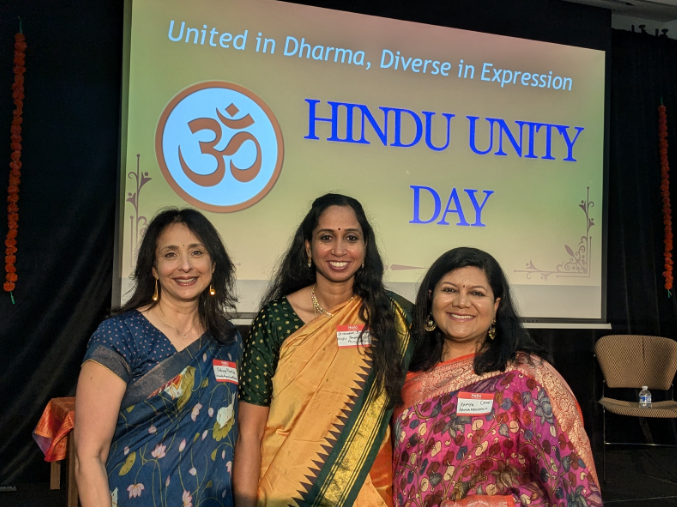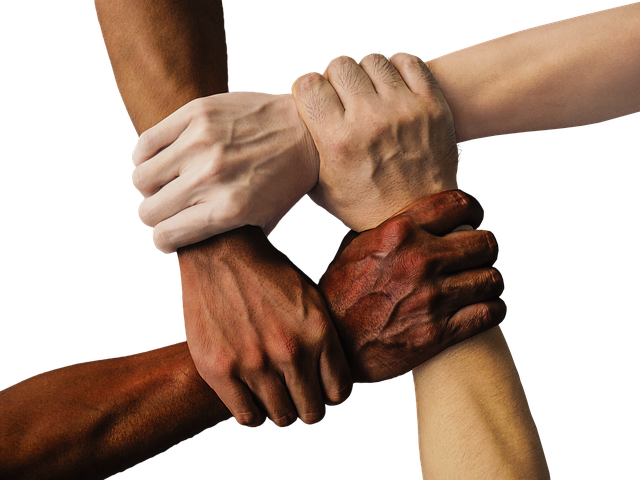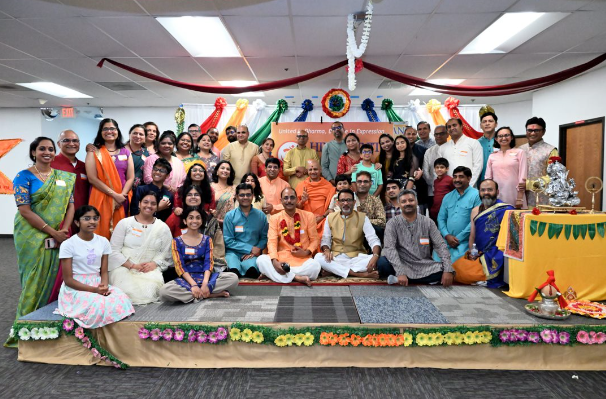

Group photo of Sacramento Hindu community members with Swami Govind Dev Giri Maharaj ji. Photo by HHS.
Hindu Unity in Sacramento
“Hindu Unity” turned out to be the theme of June 30th for me.
Earlier that day, I had attended the Hindu Unity Day in the Bay Area in Milpitas.
And later on, drove to Sacramento, to attend the Sacramento Hindu Unity Day event, also organized by the Hindu Swayamswvak Sangh. This event was very different in both its feel and messaging. This event was also attended by representatives of 50+ organizations across Greater Sacramento.
Trivia, bhajans, and a traditional welcome
While waiting for the Chief guest Swami Govind Giri Maharaj ji to arrive, the entire community participated in a fun trivia hosted by Paresh Sinha of Sewa International. This was followed by chants and bhajans (devotionals), led by the youth, who were also instrumental in decorations, the grand welcome and the program overall.
My heart always regales at the active participation of the Sacramento Hindu youth in all our programs. Also Ranajee, a senior HSS volunteer, spoke about Hindu Unity and how it largely rests on the next generation picking up and practicing the Hindu values.
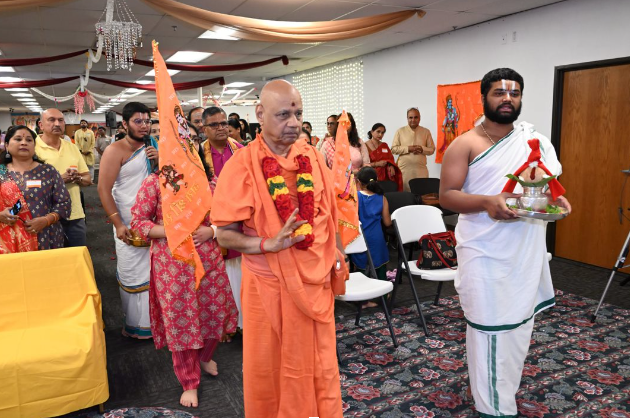
Swami Govind Dev Giri Maharaj ji receiving a religious Hindu welcome. Photo by HSS.
The Sacramento event also commenced with the traditional, auspicious welcome of Swamiji, facilitated by chanting of our mantras by pujaris (officiants) from the local Venkateshwara temple, that traces its origins to the Andhra region of India.
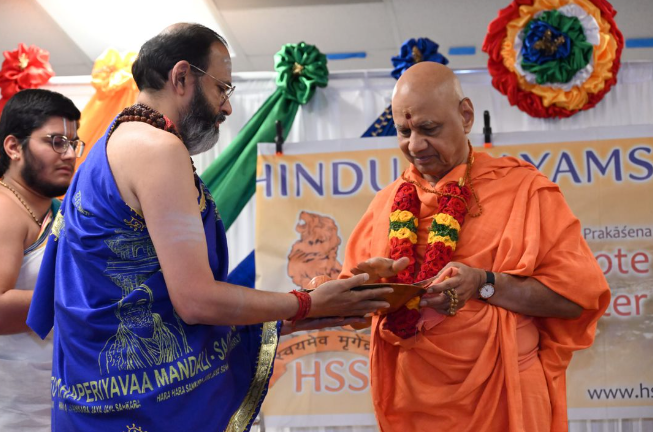
Honoring Swami Govind Dev Giri Maharaj ji. Photo by HSS.
Panch Kashivishwanathan, one of the main volunteers at the local Folsom Hindu Temple welcomed Swamiji on the behalf of the Kanchi Mahaperiva Trust. Between these two facilitations, it felt like all of the Southern Indian Hindu communities were represented. This, to me, signified that Hindus from southern India also greatly rejoice in the Ram Mandir in Ayodhya, unlike erroneous media accounts that tend to divide Hindus based on their north or southern Indian origins.
In the Sacramento event, Saumtira Ghokale, HSS Global Co-ordinator, shared examples of Hindu unity in serving communities across the globe, irrespective of their backgrounds. In the aftermath of the Ukraine- Russia war, many Hindu organizations helped in the safe return of students of all faiths, to their respective countries. This highlights a key facet of Hinduism – acknowledging the divine in all beings and their service as an essential form of devotion.
The making of Ram Mandir
Swami Govind Giri Dev’s discourse in the Sacramento event focussed on the Ram Mandir construction. He shared about the massive crowdfunding that led to the construction of the temple – how Hindus from across India whether in the cities or in remote tribal communities, whole-heartedly contributed in small and big ways. He recounted how people were waiting with tears in their eyes to be able to contribute. Even people with the most meager economic backgrounds wanted to do something for the temple. The greatest proof of the influence of Bhagwan Shri Ram was in the love, passion and faith in the eyes of all the people who actively participated in the crowd-funding.
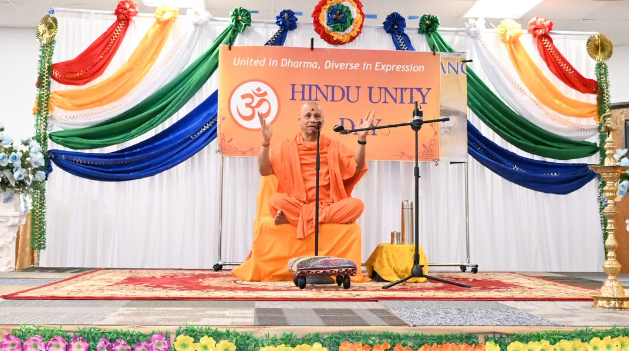
Swami Govind Dev Giri Maharaj ji giving a speech. Photo by HSS.
The construction of the Ram Mandir, he shared, was not a fight for just 2.5 acres of land. It was a highly significant historical event in the history of Hinduism and the world, where an icon of the faith was restored after 500 years of its destruction. This icon is our beloved Bhagwan Shri Ram who modeled Hindu dharma. The qualities of Bhagwan Shri Ram are for everyone to learn from and instill in their lives.
Spirituality and community
Swamiji also shared a very intriguing recount of a monkey who would visit one particular statue being carved during the construction every single day. Ultimately that statue is the one that became the main Ram murti. Also after the inauguration, a large monkey visited out of the blue, paying his pranams to the murti and ran away before anyone could take a photo. Shri Ram and his devotee Hanuman are inseparable and model the highest form of bhakti and love between God and His devotee. Swamiji’s accounts of the monkey visits, symbolic of Hanuman, during the making of the Ram mandir brought many in the audience to tears.
Swamiji finally concluded with beautiful reminders of one of the key central ethos of Hindu and Indian civilization — our acceptance of “Vasudaiva Kutmubakam” or “the world is one family”. This core teaching sets us apart- India has never once attacked another nation but only shared its valued, sacred traditions and knowledge systems spanning across science, arts, technology and spirituality.
He beseeched us to always believe in being One, to forgive and consider everyone to be ours.
Elaborating, he shared a beautiful story of Sant Gynaeshwar who was upset at being insulted while asking for alms. His sister Muktabhai asked him to forget and forgive the insult just like how we would forget and forgive our teeth when we accidentally bite ourselves! Do we take a rock and knock out our own teeth? No! We consider our teeth to be as much ours as our tongue! Thus the feeling of everybody being ours is a critical mindset to develop.
Lastly, Swamjiji shared that devotion or bhakti is the highest form of enjoyment , one that is satvik and helps in our spiritual progression. He asked us to constantly check if our lives follow the path of tamas to rajas to satvik qualities- this ensures that we follow a dharmic path.
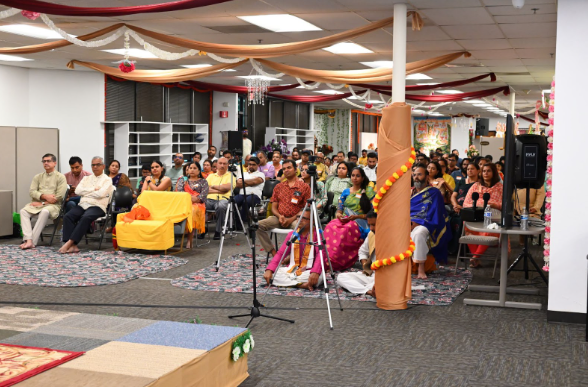
Sacramento Hindu community. Photo by HSS.
Eventually, later that evening, the Sacramento event ended with yummy snacks and social hour. I met with many old friends and made some new ones as well. Spirituality and community were at its best!
As I left the Sacramento event, I felt elated and was reminded once again of the beauty of my dharma and how fortunate I was to be born into it. So much to do but also much more to celebrate both as an individual and as a Hindu advocacy professional.
After all, HAF has been at the forefront in working with all sections of the Hindu society and with everybody in the American communities. We leave no stone unturned in advancing the rights and representation of Hindu Americans. Inter-org collaboration and advocacy at all levels is our forte.
We not only understand Hindu unity but walk the talk as well.
Krunvanto Vishwam Aryam! Jai Shree Ram!


